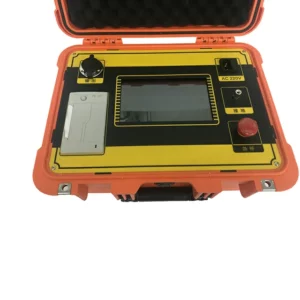In the power transmission and distribution systems, high voltage cables are critical components. Usually, we use VLF testing high voltage cables. Because over time these cables will degrade. And the high voltage cables usually be installed in open air environment. They always be impacted by various factors, such as thermal stress, mechanical damage and moisture ingress. We need know that insulation breakdown in high voltage cables can lead to costly outages. In addition, it may damage equipment and bring safety hazards. Therefore, it is importance to test the cables timely.
VLF generator: a piece of equipment used to test the integrity and insulation of high voltage cables.
How VLF generator Works: A VLF generator operates by generating low-frequency AC voltage, amplifying it to the desired level, coupling it to the cable under test using specialized devices, monitoring leakage current and other parameters during the test, and providing safety features to ensure safe operation. VLF testing is a critical method for assessing the insulation integrity of high voltage cables and ensuring the reliability and safety of power transmission and distribution networks.
And there have some benefits of VLF generator.
Safety Features: Usually, the VLF generator is equipped with various safety features to protect personnel and equipment during testing. Because for us, the first step is keeping ourselves safe.
Data Recording: Some VLF generators are equipped with data logging capabilities. Therefore, it can record test parameters and results. This feature helps us to reduce the time of recording data by ourselves. These data can be used for analysis, documentation, and reporting purposes.
Coupling Devices: Specialized coupling devices, such as capacitive couplers or resonant systems, are used to connect the VLF generator to the cable under test.

High voltage VLF testing of power cables: prevent our costly failures.
High voltage VLF testing of power cables is a specialized procedure. It always be used to assess the integrity and insulation quality of high voltage cables.
- Preparation:
Safety Precautions: Before conducting the VLF test, please ensure all safety precautions are in place. This includes proper grounding, personal protective equipment (PPE) for personnel, and isolation of the cable under test from live circuits. The first step is the most important, we must protect ourselves well.
- Voltage Application:
Voltage Adjustment: Set the VLF generator to the desired frequency and voltage level for testing. Common frequencies used in VLF testing are around 0.1 Hz.
Application to Cable: Connect the VLF generator to the cable under test using suitable coupling devices. The voltage is gradually increased to the desired level, typically reaching the rated voltage of the cable or a specified test voltage.
- Monitoring:
Leakage Current Measurement: Throughout the test, monitor the leakage current flowing through the cable insulation. An increase in leakage current may indicate the presence of defects or weaknesses in the insulation.
Waveform Analysis: Monitor the waveform of the applied voltage to ensure it remains stable and sinusoidal. Any distortions or irregularities may indicate issues with the cable or the testing setup.
- Duration and Completion:
Test Duration: The duration of the VLF test can vary depending on factors such as cable length, voltage rating, and testing standards. Common test durations range from several minutes to several hours.
Completion: Once the test duration is complete, gradually reduce the voltage and disconnect the VLF generator from the cable under test.
- Analysis and Interpretation:
Data Evaluation: If it is possible, we can analyze the data collected during the test, including leakage current measurements, waveform analysis, and any observed anomalies. This step can help us know the station of cables well.
Interpretation: when we interpret the test results, we need to base on the industry standards, manufacturer guidelines, and the specific requirements of the cable being tested. Then we can determine whether the cable insulation meets the specified performance criteria.
- Reporting and Documentation:
Documentation: Remember to document all aspects of the VLF testing procedure. We can’t ensure we do not make errors.
Reporting: Please prepare a comprehensive report to summarize the test procedure, results, and any recommendations for further action.
If you implement high voltage VLF testing of power cables according to these steps, you can get the precise date.
